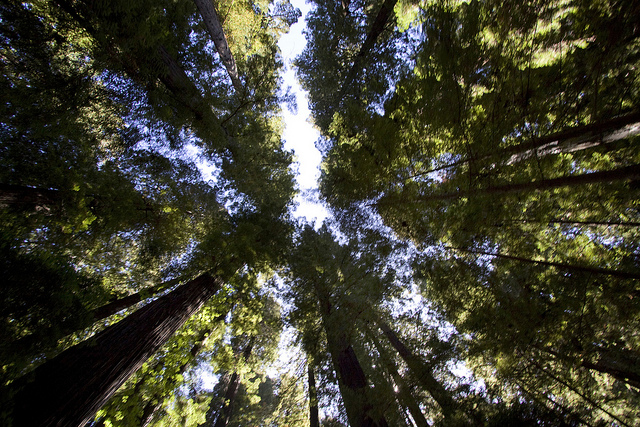Save the Redwoods League has announced the initial findings of a four year collaborative study into the impact of climate change on old growth redwood forests, with some surprising results.
Scientists and researchers from Save the Redwood League, UC Berkeley, Humboldt State University and the Marine Conservation Institute involved in the Redwoods and Climate Change Initiative, have found that changing environmental conditions have prompted a surge of growth among coastal redwoods and giant sequoias.
“We found that the redwood trees growing in our plots, in the old growth coast redwood and giant sequoia forests, are growing faster than they have over the last century,” said Emily Burns, director of science at Save the Redwoods League. “Since the 1970s we’ve seen an increase in wood production and that’s making these trees get even bigger than they were growing earlier in the 20th century.”
It turns out that changing environmental conditions borne from climate change, while detrimental to many species and ecosystems, have in fact created the ideal growing conditions for redwood forests.

measure a redwood tree for the study. Photo: Marie Antoine.
Researchers believe that increased temperatures could be lengthening the growing season for giant sequoias in the snowy Sierra Nevada, while the decrease in fog along California’s coastline means that coastal redwoods, which receive ample rainfall, are receiving more sunlight.
“Sunlight, enough water and warm conditions is the perfect recipe to grow happy redwoods,” said Burns, “and that’s what we’re seeing.”
Scientists have established 16 one-acre, permanent research sites throughout California in coastal redwood and giant sequoia ranges to monitor the health of the forest, how the trees are faring and how much carbon they are storing.
By taking tree core samples from 77 coastal redwoods and 44 giant sequoias, scientists were able to examine each annual growth ring and learn how much wood was produced on a particular tree throughout its lifetime.
According to Burns, this accelerated growth has caused older coastal redwoods in particular to increase in their girth size, growing wider rather than taller.
“We found in our study what was the fastest growing redwood and it was putting on 1.61 cubic meters of wood every year for the last decade,” said Burns. “That is the equivalent of this tree making 3.2 million pencils every year for the last decade. Which over a decade is enough to give everyone in California a pencil- and thats one tree!”
As a result of accelerated growth, northern coastal redwood forests are producing two to three times more plant biomass than any other forest in the world and storing an incredible amount of carbon.
“Not only are the redwoods growing quickly but they’re sequestering that carbon into wood that is incredibly resistant to rot, so if we leave those forests on the landscape and allow these trees to grow and die naturally on the forest floor, even as dead logs- they’re holding onto a lot of carbon,” she said.
Beyond examining the density of wood in each annual ring, the core samples have also given scientists a way to study the atoms built into the trees cellulose, known as stable isotopes. According to Burns, oxygen and carbon isotopic markers trace not only climatic conditions occurring during the tree’s time of growth but also how the tree responded to the conditions.
“We have to be able to tease apart whether it was temperature, precipitation or fog that was influencing the oxygen signature and then how much that tree was transpiring- in effect, sweating- during the period of those climate conditions,” said Burns.
“So as we can fine tune and understand exactly what these chemical traces are telling us about climate then we’re going to be able to apply it back to previous centuries and maybe even previous millennia.”
But of course, no positive climate change story is without a catch.
So far, climate change has had a positive impact on coastal redwoods and giant sequoias however that doesn’t mean they will continue to respond well to constantly increasing temperatures or high atmospheric carbon levels.
More so, the study has so far been limited to old growth forests as a way of establishing a baseline before including seedlings and younger forests, which are perhaps most at risk from climate change.
With the initiative in its fourth year, researchers are now looking to the next phase of the project and hoping to include different variables such as other plant and wildlife, studying second growth redwood forests and of course, monitoring the established plots.
“When you establish something as our crews have done and know an awful lot about what’s on those one hectare plots, they become really valuable when you continue to watch them over a long period of time,” said William ‘Bill’ Libby, professor emeritus of forest genetics at UC Berkeley and an advisor to the initiative.
“And so we’re also thinking in terms of very long period time- like 100 years minimum- in terms of the amount of time we want to keep these things active,” he said.
While climate change is rarely a story of hope or happiness, there is a glimmer of both in the prospect that California’s gentle giants can not only flourish in a changing climate but may in fact help us ameliorate its effects.
“I think what we’re realizing, and it’s such a hopeful story, that when redwoods have enough access to water even if it does warm up- under the current amount of warming it is a great condition for redwoods,” said Burns.
“Its wonderful to know that these refuges that we go and visit and hike in ourselves will to continue to be there,” she said.
Alessandra Bergamin is a Bay Nature editorial intern.





